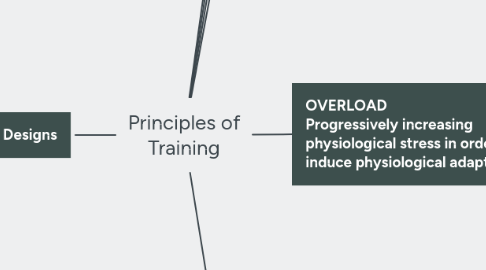
1. Study Designs
1.1. Cross-sectional Study Design
1.1.1. examining different individuals
1.2. Longitudinal study Design
1.2.1. Following the same individual over time
2. OVERTRAINING
3. REVERSIBILITY/DETRAINING
4. ADAPTATION
5. RECOVERY
6. OVERLOAD Progressively increasing physiological stress in order to induce physiological adaptations
6.1. Requires understanding of - Volume/milage - Frequency - Intensity - Duration - Recovery
6.1.1. Duration and Intensity appear to be considerably important factors for acute anaerobic and aerobic adaptations
6.2. Aerobic - Volume and Frequency
6.2.1. little is known what is ideal/optimal
6.2.2. ACSM guidelines (general health cardiovascular) =30 min moderate exercise most days - 5 days p/week
6.2.3. National/international athletes typically - 30 min - 6hrs (sports specific, 6-7 days p/week
6.2.4. volume influenced largely by intensity - similar adaptations can be observed with halving training volumes and increases in intensity
6.2.4.1. study on swimming training volume reduced from 60-80 km/wk to 20-30km/wk --> found adaptations of fitness but had increased markers of overtraining
6.2.5. Study: training once (high) vs twice daily (low): conflicting results, twice daily: - reduces CHO availability - increases physiological stress - reduces exercise intensity
6.3. Aerobic - Intensity and Duration
6.3.1. - Traditionally, high volumes moderate intensity exercise - 60-80% VO2 max - Thought increases above 80% VO2max may reduce aerobic adaptations of slow twitch muscle fibres -probably due to decrease in recruitment rather than intensity
6.3.2. recent evidence suggest time in at high intensity maximizes aerobic adaptation - principle of interval training
6.3.2.1. Study: -burgomaster = 30 Wingate (SIT) vs 40-60 min ~ 65% VO2 max (ET)| - Abiss = 4 min single leg vs double leg cycling
6.4. Interval Training
6.4.1. Series of repeated bouts of exercise alternated with periods of rest (Work interval and Relief interval)
6.4.2. A certain amount of energy is needed to perform a quantity of work irrespective of whether the work is done continuously or intermittently
6.4.3. The crucial different is that different energy systems can be brought into play depending on "how" you do the work (aerobic vs anaerobic)
6.4.4. Interval Training Principles
6.4.4.1. Application of the overload principle can be influenced by manipulating:
6.4.4.1.1. 1 Intensity of exercise
6.4.4.1.2. 2 Duration of work interval
6.4.4.1.3. 3 Duration of relief interval
6.4.4.1.4. 4 Number of work-relief repetitions
6.4.4.2. Factors overloaded will depend on specificity and training program periodisation
6.4.5. Measuring training intensity
6.4.5.1. Blood Lactate
6.4.5.1.1. Quantification of the level of anaerobic metabolism
6.4.5.1.2. Individual training will alter relationship
6.4.5.2. Heart Rate
6.4.5.2.1. A good indication of relative exercise intensity
6.4.5.2.2. Training will alter relationship
6.4.5.3. RPE
6.4.5.3.1. Subjects can be trained to recognize perceptual changes associated with lactate accumulation
6.4.5.4. Training pace / velocity
6.4.5.4.1. Quick and easy
6.4.5.4.2. does not take into account individual differences
7. SPECIFICITY Making training specific to task being performed
7.1. .
7.1.1. Exercise task specific - cycling vs running etc
7.1.2. Movement specific - requires and understanding of functional anatomy (training specific muscle action) - flexibility, agility, range of motion etc
7.1.3. Speed/ Velocity specific - training at low velocity can increase strength but not necessarily high velocity power
7.1.4. Tissue / Organ specific - central vs peripheral adaptations
7.1.5. Energy system specific - stress to energy systems important to event
